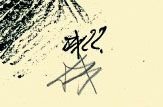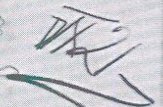Early art prints were usually “signed” with initials in the plate. In the mid-1890s, the buying public started to demand a more personal touch. By the early 20th century, most art prints were signed by the artist.
This is true for the work of Otto Dix. He generally signed each print in the published series. Unsigned prints, although still somewhat valueable, were probably extras with minor imperfections. If you purchase an unsigned print, make sure its provenance is secure.
 Otto Dix usually signed his prints in pencil in the lower right corner. The signature can appear in the margin or in the print itself. It is characterized by three capital letters, “DIX”. The signature on the left provides an excellent example. This later example has a nice fluent movement connecting the letters. Earlier examples were much more pointed.
Otto Dix usually signed his prints in pencil in the lower right corner. The signature can appear in the margin or in the print itself. It is characterized by three capital letters, “DIX”. The signature on the left provides an excellent example. This later example has a nice fluent movement connecting the letters. Earlier examples were much more pointed.
 It’s not uncommon for a print to contain two signatures. Dix would etch one in the plate then sign his name beneath it. This was not an uncommon practice. Many printmakers signed the plate, then penciled their signatures on the series. This way the overruns can still be attributed to the artist.
It’s not uncommon for a print to contain two signatures. Dix would etch one in the plate then sign his name beneath it. This was not an uncommon practice. Many printmakers signed the plate, then penciled their signatures on the series. This way the overruns can still be attributed to the artist.
 While probably unintended, Dix simplified the task for those who catalog his work by dating many of his pieces. He generally added the year in two-digit form similar to this example. “21” denotes the year 1921.
While probably unintended, Dix simplified the task for those who catalog his work by dating many of his pieces. He generally added the year in two-digit form similar to this example. “21” denotes the year 1921.